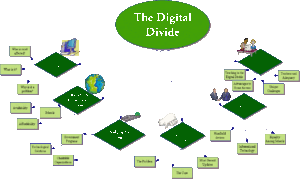Back to: Computer Science JSS 3
Welcome to class!
In today’s class, we shall be talking about the concept of digital divide. Please enjoy the class!
Imagine a world where information flows freely, opportunities abound online, and education is just a click away. This is the promise of the digital age, but for many, it remains an unfulfilled dream. The digital divide refers to the gap between those who have access to technology and those who don’t. It’s a complex issue with far-reaching consequences, impacting everything from education and employment to social inclusion and economic development.
Digital Divide – The Concept of Digital Divide

The digital divide manifests in various ways:
- Access: Not everyone has reliable internet connection or owns devices like smartphones or computers. Rural areas, low-income communities, and developing countries often lag behind in infrastructure and affordability.
- Digital literacy: Even with access, some lack the skills and knowledge to navigate the online world effectively. This can range from basic computer skills to critical thinking and information literacy.
- Language and content: Much of the internet’s content is in English, creating a barrier for non-native speakers. Additionally, culturally relevant content might be scarce in certain regions.
Consequences of the Digital Divide:
The digital divide has profound consequences for individuals and societies:
- Education: Online learning platforms and resources offer immense educational opportunities, but those without access are left behind. This can widen the achievement gap and perpetuate social inequalities.
- Employment: Digital skills are increasingly in demand across various sectors. Lacking these skills limits job opportunities and restricts upward mobility.
- Social inclusion: Online communities and platforms provide avenues for communication, collaboration, and participation. Those excluded from the digital world risk social isolation and marginalization.
- Economic development: Digital technologies drive innovation and economic growth. Countries with a wider digital divide struggle to compete in the globalized economy.
Bridging the Gap:
Addressing the digital divide requires a multi-pronged approach:
- Infrastructure development: Expanding internet access, particularly in underserved areas, is crucial. This includes investing in broadband networks, public Wi-Fi hotspots, and affordable data plans.
- Digital literacy training: Equipping individuals with the skills to use technology effectively is essential. This includes basic computer skills, online safety awareness, and critical thinking skills for navigating the digital world.
- Language localization and culturally relevant content: Creating content in diverse languages and catering to local needs can make the internet more inclusive and accessible.
- Public-private partnerships: Collaboration between governments, businesses, NGOs, and communities is essential for developing and implementing effective solutions.
The digital divide is not an inevitable reality. By working together, we can bridge the gap and ensure that everyone has the opportunity to participate in the digital world. Only then can we truly unlock the potential of technology for a more inclusive, equitable, and prosperous future.
By making the issue of the digital divide relatable and engaging, we can inspire future generations to bridge the gap and create a more connected world.
We have come to the end of today’s class. I hope you enjoyed the class!
In the next class, we shall be discussing the features of the old economy.
In case you require further assistance or have any questions, feel free to ask in the comment section below, and trust us to respond as soon as possible. Cheers!
Question Time:
(a) Define the term “digital divide” and explain two main factors that contribute to it. (4 marks)
(b) Discuss the negative consequences of the digital divide on education and employment opportunities in developing countries. (6 marks)
(c) Outline three concrete steps that governments and communities can take to bridge the digital divide. (5 marks)

i enjoyed this class,please i want to ask the types of digital divide
I enjoyed the lesson but is there example of digital divide